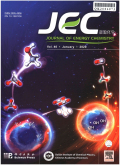- 钛学术文献服务平台 \
- 学术期刊 \
- 工业技术期刊 \
- 石油与天然气工业期刊 \
- 能源化学期刊 \
High-performance zinc-ion batteries enabled by electrochemically induced transformation of vanadium oxide cathodes
High-performance zinc-ion batteries enabled by electrochemically induced transformation of vanadium oxide cathodes
基本信息来源于合作网站,原文需代理用户跳转至来源网站获取
摘要:
Rechargeable aqueous zinc-ion batteries(ZIBs)have become a research hotspot in recent years,due to their huge potential for high-energy,fast-rate,safe and low-cost energy storage.To realize good electro-chemical properties of ZIBs,cathode materials with prominent Zn2+ storage capability are highly needed.Herein,we report a promising ZIB cathode material based on electrochemically induced transformation of vanadium oxides.Specifically,K2V6O16·1.5H2O nanofibers were synthesized through a simple stirring method at near room temperature and then used as cathode materials for ZIBs in different electrolytes.The cathode presented superior Zn2+ storage capability in Zn(OTf)2 aqueous electrolyte,including high capacity of 321 mAh/g,fast charge/discharge ability(96 mAh/g delivered in 35 s),high energy density of 235 Wh/kg and good cycling performance.Mechanism analysis evidenced that in Zn(OTf)2 electrolyte,Zn2+ intercalation in the first discharge process promoted K2V6O16·1.5H2O nanofibers to transform into Zn3+ xV2O7(OH)2·2H2O nanoflakes,and the latter served as the Zn2+ -storage host in subsequent charge/dis-charge processes.Benefiting from open-framework crystal structure and sufficiently exposed surface,the Zn3+ xV2O7(OH)2·2H2O nanoflakes exhibited high Zn2+ diffusion coefficient,smaller charge-transfer resis-tance and good reversibility of Zn2+ intercalation/de-intercalation,thus leading to superior electrochem-ical performance.While in ZnSO4 aqueous electrolyte,the cathode material cannot sufficiently transform into Zn3+ xV2O7(OH)2·2H2O,thereby corresponding to inferior electrochemical behaviors.Underlying mechanism and influencing factors of such a transformation phenomenon was also explored.This work not only reports a high-performance ZIB cathode material based on electrochemically induced transfor-mation of vanadium oxides,but also provides new insights into Zn2+ -storage electrochemistry.

推荐文章
Rapid and sensitive method for determining free amino acids in plant tissue by high-performance liqu
HPLC
OPA
FMOC
Free amino acids
Plant
PLS-DA
Synthesis of zinc oxide–montmorillonite composite and its effect on the removal of aqueous lead ions
Synthesis
Characterization
Zinc oxide–montmorillonite composite
Adsorption, Pb2+ ions
The vanadium isotopic composition of L ordinary chondrites
V isotopes
L ordinary chondrites
Variation
内容分析
关键词云
关键词热度
相关文献总数
(/次)
(/年)
引文网络
引文网络
二级参考文献 (0)
共引文献 (0)
参考文献 (1)
节点文献
引证文献 (0)
同被引文献 (0)
二级引证文献 (0)
2021(1)
- 参考文献(1)
- 二级参考文献(0)
2021(1)
- 参考文献(1)
- 二级参考文献(0)
- 引证文献(0)
- 二级引证文献(0)
引文网络交叉学科
相关学者/机构
期刊影响力
能源化学
主办单位:
中国科学院大连化学物理研究所
中国科学院成都有机化学研究所
出版周期:
双月刊
ISSN:
2095-4956
CN:
10-1287/O6
开本:
出版地:
大连市中山路457号
邮发代号:
创刊时间:
语种:
eng
出版文献量(篇)
2804
总下载数(次)
0
总被引数(次)
7996
期刊文献
相关文献
推荐文献
- 期刊分类
- 期刊(年)
- 期刊(期)
- 期刊推荐
一般工业技术
交通运输
军事科技
冶金工业
动力工程
化学工业
原子能技术
大学学报
建筑科学
无线电电子学与电信技术
机械与仪表工业
水利工程
环境科学与安全科学
电工技术
石油与天然气工业
矿业工程
自动化技术与计算机技术
航空航天
轻工业与手工业
金属学与金属工艺
能源化学2022
能源化学2021
能源化学2020
能源化学2019
能源化学2018
能源化学2017
能源化学2016
能源化学2015
能源化学2014
能源化学2013
能源化学2012
能源化学2011
能源化学2010
能源化学2009
能源化学2008
能源化学2007
能源化学2006
能源化学2005
能源化学2004
能源化学2003
能源化学2002
能源化学2001
能源化学2021年第9期
能源化学2021年第8期
能源化学2021年第7期
能源化学2021年第6期
能源化学2021年第5期
能源化学2021年第4期
能源化学2021年第3期
能源化学2021年第2期
能源化学2021年第12期
能源化学2021年第1期

 免费查重
免费查重










